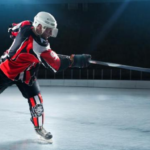Under a hockey jersey, wear a moisture-wicking base layer and padding for protection. Avoid bulky clothing to ensure mobility.
Choosing the right attire under your hockey jersey is crucial for comfort and performance. A moisture-wicking base layer helps manage sweat, keeping you dry throughout the game. This layer should fit snugly to prevent chafing and enhance mobility. Padding, such as shoulder pads and elbow guards, provides essential protection against impacts.
Opt for breathable, lightweight materials to avoid overheating. Proper attire not only safeguards your body but also enhances your gameplay. Avoid bulky or restrictive clothing that can hinder your movement. With the right under-jersey gear, you can stay comfortable, protected, and focused on the game.

Credit: www.reddit.com
Choosing The Right Base Layer
Choosing the right base layer is crucial for comfort and performance. A good base layer can keep you warm and dry. It also helps to prevent chafing and irritation. Below, we explore different material options and moisture-wicking fabrics.
Material Options
Base layers come in various materials. Each has its own advantages.
- Cotton: Soft and comfortable. Not ideal for moisture control.
- Polyester: Lightweight and dries quickly. Good for high-intensity play.
- Merino Wool: Warm and breathable. Suitable for colder climates.
- Nylon: Durable and strong. Often blended with other materials.
Moisture-wicking Fabrics
Moisture-wicking fabrics are essential for keeping you dry. These fabrics pull sweat away from your skin.
| Fabric Type | Benefits |
|---|---|
| Polyester | Lightweight, dries quickly, affordable. |
| Merino Wool | Warm, breathable, natural odor control. |
| Nylon | Durable, strong, often used in blends. |
| Spandex | Stretchy, form-fitting, often used in athletic wear. |
Using moisture-wicking fabrics helps in maintaining comfort. It also boosts your overall performance on the ice.

Credit: www.reddit.com
Importance Of Fit
Wearing the right clothing under your hockey jersey is crucial. The fit of your underlayers impacts your comfort and performance on the ice. A proper fit ensures you stay warm, dry, and able to move freely. Let’s explore the importance of fit and how to achieve it.
Compression Vs. Loose Fit
Choosing between compression and loose fit underlayers can make a big difference. Compression gear fits tightly against your body. It provides support and helps with blood flow. Loose-fit clothing allows more air circulation. It can be more comfortable for some players.
| Compression Fit | Loose Fit |
|---|---|
| Provides muscle support | Allows more air circulation |
| Improves blood flow | Offers a relaxed feel |
| Reduces muscle fatigue | May be less restrictive |
Layering Techniques
Layering is key to staying comfortable on the ice. Using the right layering techniques can help you stay warm and dry. Here are some tips:
- Base Layer: Start with a moisture-wicking base layer. This keeps sweat away from your skin.
- Mid Layer: Add an insulating layer. This helps to retain body heat.
- Outer Layer: Your hockey jersey is the outer layer. It should fit comfortably over your other layers.
Each layer plays a crucial role in maintaining your comfort. Ensure your layers are not too bulky. You should be able to move freely. Proper layering can make a big difference in your performance.
Temperature Considerations
Wearing the right gear under your hockey jersey is crucial. The temperature plays a key role in your comfort and performance. Let’s break down what you need to wear in different weather conditions.
Cold Weather Gear
Hockey games in cold weather require extra layers. This helps maintain your body heat and keeps you comfortable during the game.
- Base Layer: Start with a moisture-wicking base layer. It keeps sweat away from your skin.
- Thermal Shirt: Add a thermal shirt. This provides extra warmth.
- Insulated Pants: Wear insulated pants under your hockey pants. This keeps your legs warm.
- Gloves: Consider wearing thin gloves under your hockey gloves. This adds an extra layer of warmth.
| Gear | Purpose |
|---|---|
| Base Layer | Wicks sweat away |
| Thermal Shirt | Provides warmth |
| Insulated Pants | Keeps legs warm |
| Gloves | Adds warmth to hands |
Warm Weather Adjustments
In warm weather, keeping cool is the priority. You need lightweight and breathable gear.
- Light Base Layer: Opt for a light, breathable base layer. It helps regulate your body temperature.
- Short-Sleeve Shirt: Wear a short-sleeve shirt. This allows better air circulation.
- Compression Shorts: Use compression shorts. They keep you cool and support your muscles.
- Lightweight Socks: Choose lightweight, moisture-wicking socks. They keep your feet dry and cool.
| Gear | Purpose |
|---|---|
| Light Base Layer | Regulates temperature |
| Short-Sleeve Shirt | Allows better air flow |
| Compression Shorts | Supports muscles |
| Lightweight Socks | Keeps feet dry |
Protective Gear Integration
Wearing a hockey jersey involves more than just the jersey itself. Protective gear integration is essential for safety and performance. Below, we discuss how to seamlessly integrate protective gear under your hockey jersey.
Padding Placement
Proper padding placement ensures safety and comfort. The key areas to focus on are:
- Shoulders: Shoulder pads protect from hits and falls.
- Elbows: Elbow pads prevent injuries during collisions.
- Chest and Back: Chest protectors absorb impacts.
Each piece of padding must fit well. It should not shift during movement. Tighten straps and adjust sizes for a snug fit.
Seamless Integration
Seamless integration of gear ensures maximum mobility. Here’s how to achieve it:
- Layering: Wear a base layer to prevent chafing.
- Compression Garments: Use compression shirts and shorts for better fit.
- Strap Management: Tuck in all straps and laces securely.
Seamless integration also involves using gear that complements each other. For example, choose elbow pads that fit well under shoulder pads.
Here’s a quick reference table for easy understanding:
| Body Part | Protective Gear | Importance |
|---|---|---|
| Shoulders | Shoulder Pads | High |
| Elbows | Elbow Pads | High |
| Chest and Back | Chest Protector | High |
Pay attention to these details to ensure your safety and comfort on the ice.
Preventing Chafing
Preventing chafing is essential when wearing a hockey jersey. Hockey players often experience irritation due to constant movement. Proper gear helps you stay comfortable. Learn how to prevent chafing with the right products and sizing.
Anti-chafing Products
Invest in quality anti-chafing products to protect your skin. These products reduce friction and irritation.
- Anti-Chafing Creams: Apply these creams before putting on your jersey. They create a barrier on your skin.
- Powders: Use powders to keep your skin dry and reduce moisture.
- Anti-Chafing Balms: These balms provide long-lasting protection against rubbing.
Using these products can make a big difference. They help you focus on the game, not the discomfort.
Proper Sizing
Proper sizing of your hockey jersey is crucial. An ill-fitting jersey can cause chafing. Follow these steps to ensure a good fit:
- Measure: Measure your chest and waist for accurate sizing.
- Try On: Always try the jersey on before purchasing.
- Check Movement: Move your arms and torso to check for any tightness.
A well-fitted jersey should not be too loose or too tight. It should allow free movement without rubbing.
Using proper sizing and anti-chafing products will enhance your comfort. This ensures you enjoy the game without distractions.

Credit: www.theodysseyonline.com
Breathability And Ventilation
Hockey can be an intense sport. Players need to stay cool and comfortable. What you wear under your hockey jersey matters. Breathability and ventilation are key.
Mesh Inserts
Mesh inserts are very important. They help air flow through your clothing. This keeps you cool during the game. Many base layers have mesh panels. These panels are often placed under the arms. They can also be on the back. Mesh inserts let sweat evaporate quickly. This keeps you dry and comfortable. Some hockey jerseys also have mesh inserts. They add extra ventilation.
Ventilated Fabrics
Ventilated fabrics are designed to breathe. They let air pass through easily. This helps keep your body temperature down. There are many types of ventilated fabrics. Some are made with tiny holes. Others use special weaving techniques. Look for fabrics labeled as “moisture-wicking” or “breathable.” These fabrics pull sweat away from your skin. They dry quickly and keep you cool.
| Feature | Benefit |
|---|---|
| Mesh Inserts | Enhanced airflow and cooling |
| Ventilated Fabrics | Quick drying and moisture management |
Maintaining Hygiene
Maintaining hygiene is crucial when wearing a hockey jersey. Proper care keeps you fresh and healthy. Let’s explore how to maintain hygiene effectively.
Washing Guidelines
Follow these guidelines to keep your jersey clean and fresh:
- Wash your jersey after every game.
- Use cold water to preserve fabric quality.
- Avoid using bleach or harsh detergents.
- Turn the jersey inside out before washing.
- Let it air dry instead of using a dryer.
Odor Control
Controlling odor is vital for maintaining hygiene. Here are some tips:
- Use anti-bacterial sprays before and after games.
- Always wear a moisture-wicking base layer.
- Store your jersey in a ventilated area.
- Consider using odor-absorbing products like baking soda.
By following these steps, you can keep your hockey jersey fresh and clean. Maintaining hygiene is essential for your well-being and performance.
Personal Preferences
Choosing what to wear under a hockey jersey can be personal. Each player has unique needs and comfort levels. Some prefer specific clothing items. Others experiment until they find the perfect fit.
Customizing Your Layers
Customizing your layers can make a big difference. Some players like wearing moisture-wicking shirts. These shirts keep you dry during intense games. You might also wear compression gear. Compression gear supports muscles and improves circulation.
Long-sleeve shirts are another option. They add warmth and protect your skin. In colder arenas, thermal layers might be needed. Choose what’s right for you and your comfort.
Trial And Error
Finding the perfect undergarment requires trial and error. Start with basic items like t-shirts and compression shorts. Play a few games and see how they feel. Adjust as needed for comfort and performance.
Some players prefer short-sleeve shirts. Others might choose tank tops for more freedom. Test different clothing items and combinations. Note how they affect your play and comfort.
Keep experimenting until you find the best fit. Everyone’s body and preferences are different. What works for one person might not work for another.
Conclusion
Choosing the right gear under your hockey jersey enhances performance. Prioritize comfort, breathability, and protection. Consider moisture-wicking fabrics and proper padding. Remember, the right base layers make a difference on the ice. Stay comfortable and focused during the game. Your hockey performance will thank you.


